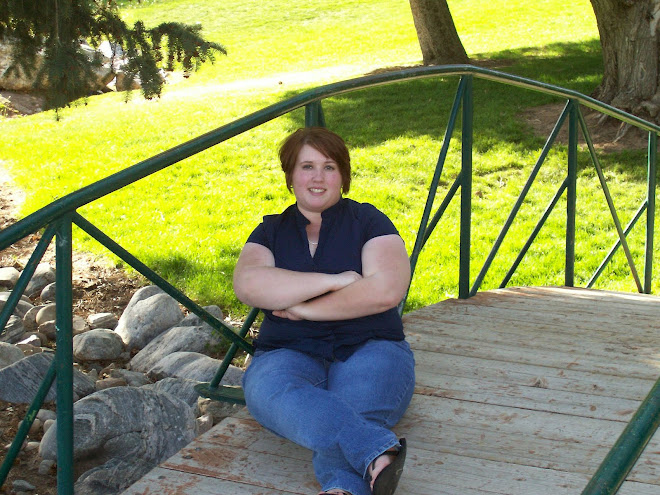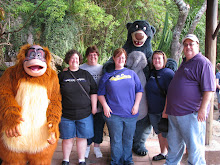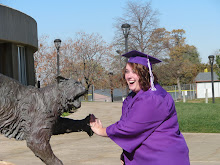Journal #1
January 2, 2012
Taking these few classes within the education program is something I have been working towards for several years now. To actually be enrolled in the classes, sitting in orientation, and listening to the things I will be accomplishing is a reality that seemed like a distant dream. I felt like every emotion was surging through my body; however, in the end I felt excited and ready dive into the work.
Orientation was exactly what was needed to put my mind at ease regarding a few tasks that would be completed in the distant future. The first was the Praxis Exam. I was unsure of when to actually take the exam, I had been told that it is suggested to take it before you student teach---but how far in advance? After discussing the exam, I now know it is something I need to begin studying for. My goal is to study a few hours a week for it and plan on taking it by the end of Spring Semester (seeing how I will not be student teaching until next spring). Also, after hearing from Ana Eldredge that the majority of Weber State University students pass the Praxis on their first try I feel a lot more confident in taking the exam!
Student teaching was another aspect I was concerned about. It was described to us in class today as an opportunity. I had never thought of it this way and truly that is what it is. An opportunity to learn—learn how to properly interact with our students, learn how to communicate effectively, and learn how to implement the items we have prepared. It is an opportunity to grow---to see where we are strong and weak, but have the chance to work on it and improve. It is an opportunity to put our name out in the work field—working with teachers, administrators, and the district is a chance to show them what we are capable of.
To finish up today, I would like to write down my goals and hopes for this semester.
Goal #1: Complete every assignment on time
Goal #2: Maintain an A in each class
Goal #3: Take every opportunity to learn and grow—this semester is created just for that. I need to be able to learn as much as possible in order to be the type of teacher I want to be.
Goal #4: Enjoy every experience---I often do not take the time to enjoy what is around me. I need to in order to grow in the opportunities I am having!
Journal #2
January 3, 2012
Why does one choose to go into teaching? I have pondered this question many times throughout my life. Do they teach to inspire, to gain favor in the eyes of someone, or merely to gain riches? Well, I know the answer that most teachers or those who are planning on teaching would respond with. I found it interesting what Dr. Moulding stated in class today about why we teach. It is not for riches; unfortunately teachers are not paid as well as other professions. However, Dr. Moulding we teach to make a difference, to feel like we have touched someone’s life in a positive way. She shared a story with us about a student that is in the morning block. She stated, “There is a student that is in the morning block whose brother I taught at Fremont. While thinking of this student, I remembered he had done something for me. I went to my file cabinet that houses all of the things students have given me (notes, cards, funny cartoons). I began to search through to the years I was at Fremont and finally found what he had given me.” Dr. Moulding then said, “This is why we teach! These cards and notes are our riches.”
I chose to teach, because I was inspired by a former teacher. My third grade teacher, Miss Higgs, was the type of teacher who was stern and one that put the “fear” into her students. On occasion though she would show you how incredible she truly was. One particular day I struggled with my cursive writing. Miss Higgs helped me and told me that she would never give up on me therefore I couldn’t give up on myself. Being the type of teacher who enjoys what they do, does it well, and is willing to continue to learn is the type that will be the most successful. They are the ones that will inspire, teach, and instill knowledge into the students they teach.
One other thing that stood out to me the most in today’s class was Dr. Moulding was discussing what our main priority is as teachers. Our main priority is not to just deliver content to the students. However, our primary goal is to assess what the students are learning. There are several methods of how to assess students; which we will learn throughout the semester. It is our responsibility to make sure our students are learning and understanding what we are saying. If they are not then we are not teaching we are merely talking.
Journal #3
January 4, 2012
What does it mean to work with diverse learners? Many people believe teaching is standing in front of a room lecturing on a particular subject, and quite frankly I used to be one of those people several years ago. I guess when you are young you do not realize the heart and effort that your teachers put into a day’s work. Growing up I never thought about my teachers trying to include each person into the lesson—I guess I thought it just happened naturally. However, as time as progressed, as I have matured, and as I have learned more about teaching I have come to see that teaching takes planning, implementing, time management, and especially understanding of how to meet the needs of each student.
In today’s class, Dr. Crawford, discussed our obligations as teachers. What do we need to do in order to include/teach each and every student? One of the things that has stood out to me the most and has made me ponder frequently was the concept of “dummying down”. How many people/teachers believe that they must “dummy down” their particular lesson plan? I am sure there are several who feel that their lesson plans are too far intellectual for someone who does not speak English as their first language, or even for someone who may have autism. However, I personally (as well as those within my class) feel that we do not have to “dummy down” anything for our students. The answer of how to reach those students on different levels is to modify our instructions. We may have to give more instructions to one particular student rather than giving them a list all at once. We may have to say it a different way so someone can grasp the concept, even though the concept is exactly the same as it is for the other students. My favorite statement that was made today was, “different from, is not less than”. We as teachers need to be able to give each and every student the same opportunity as the next student.
One final note from today’s class that I found quite informative was about culture. Culture is a catalyst for how differences play out in society. Culture is learned, it is important for students to understand its importance. Culture is shared; we share it with our neighbors, our students, our friends. Culture is adaptable, it is not fixed- yet it is always changing. Finally, culture is dynamic change, our culture and society does not live in isolation—it is a global society, a connective society, and it has influence on many things such as our economy.
Journal #4
January 5, 2012
Evaluation is a continuous process which makes use of multiple methods of gathering relevant data for instructional purposes. Dr. Gowans mentioned that there are two types of evaluations: formative and summative. What do these evaluations mean? Why are evaluations important? What are some types of evaluations I as a teacher will be conducting?
Dr. Gowans never defined the two types of evaluations that we have and it intrigued me to know what they are and what they actually mean. Formative evaluation is a type of evaluation which has the purpose of improving programs; whereas summative evaluation is the assessment of the learning and summarizes the development of learners at a particular time. After a period of work, (e.g. a unit for two weeks, the learner sits for a test and then the teacher marks the test and assigns a score). As a student, I personally, never realized that there were different types of assessments that teachers put forth. I usually read the chapters, did the assignments, and then took the tests. However, I know realize that there is so much more to evaluations. It is important that a teacher takes the time to not only do a summative evaluation on the particular subject, but also take the time to do a formative evaluation. The teacher needs to discover what is important to convey the information, how they can better prepare the students, and to make sure that what they are teaching and how they are teaching is actually preparing the students for the future.
I guess my understandings of evaluations have changed. There are several reasons to give a test to a student, such as: to place students, to serve as standards, to assist teachers to be diagnostic, prescriptive, and definitive. They can also be used to form ideas about the student’s progress, demonstrate mastery, make predictions, compare self with other students, and to verify or nullify judgments about instructional effectiveness.
Assessments are probably one of the most, if not the most important step in bettering yourself as a teacher. It is our ways of judging our effectiveness of presenting information. It is our only way of judging if our students are grasping the information. It is also an important way of making sure we stay on task of what is expected of us as teachers!
Journal #5
January 6, 2012
When I chose to become a teacher, I had dreams of what I wanted to teach and how I was going to teach. I often would daydream of different concepts, ideas, and activities that I thought would go perfect with certain subject areas. Then one day I found out about curriculums and core content. When I was younger I did not realize that there was set instructions that a student “had to learn”. As I have become older, I now know that I can incorporate my different ideas into the core curriculum to help get my point across, but I need to first set priorities.
Within class today we discussed curriculum and Bloom’s Taxonomy. I have to say that part of the taxonomy was a bit confusing at first. I understand now the importance of making sure that you are covering different areas for students—helping them become a well-rounded student/person. I learned today that as a teacher I need to set priorities—I need to look at the curriculum and make decisions that will benefit my students and decide what needs to be taught, what can wait, and what can be completely cut out. Besides assessments, I personally feel that this is going to be one of the trickier tasks of being a teacher. Dr. Moulding made a statement that put this tricky realization into my mind, “teaching is a deliberate and conscious act”. It truly takes thought, imagination, and a large amount of planning.
One final thing that I want to remember about today’s class is: curriculum is our guidance. It guides our student’s learning and it guides our teaching. Within our teaching it helps us figure out our intended material which is our formal curriculum—the standards based on what we as teachers need to teach.
In curriculum we can also have hidden concepts, things we do not mean to teach or things that are taught by our actions. I found this part of class very intriguing. As I look back on my education I now see that some of my confidence, beliefs, honesty, integrity, and work ethics come from my education. Again, as Dr. Moulding stated “teaching is a deliberate and conscious act”. We as teachers need to be aware of what we say, do, act, dress, etc… because we never know what student is picking up on these little traits of ours.
Journal #6
January 9, 2012
How do we view the world around us? What are the important factors of who we are and what we do? Today’s class got me thinking about scenarios and ideas that has never entered my mind before; Dr. Crawford often has a way of making me think differently!
Class began as normal, except for of having everyone stand while they Dr. Crawford read us four different scenarios. While he read we were supposed to think of which person we would less like to be. As he read through each case: the migrant parents who cannot communicate with their child’s teacher, the gifted student who has physical deformities, the girl hiding the fact she is gay because she is afraid of what will happen to her, or the gifted athlete who does not know how to read or write—I thought to myself, I don’t want to be any of these people. Each one has their own difficulties and problems. However, we had to choose one to say we would least like to be.
I chose the athlete who cannot read or write. At the time I did not really know why I chose this particular scenario, but now that I am home thinking about it I know. Reading and writing are a huge part of my life—they make up who I am. Soon the athlete’s skills of sports will fade, but then what? If you do not even have a basic education of reading and writing, how do you make it in the world—especially in today’s society? I also started to think about how this athlete would get to the point of not being able to read or write. In my opinion the athlete obviously does not have parental support, or someone at home to turn to. It is also apparent that teachers/coaches have not taken the time with this particular scenario. I would never want to be in this particular situation.
These scenarios showed us as soon-to-be teachers an inside look into some situations we may be placed into. It is our responsibility to not push the students aside, but to take a closer look and make sure we, as the teacher, are doing our absolute best.
Reading/Writing Connection Chapter 6
13 years ago




No comments:
Post a Comment